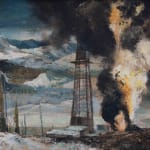York Wilson Canadian, 1907-1984
Further images
The painting Oil Wells by York Wilson captures a dramatic moment in an industrial winter landscape, likely illustrating the rugged oil fields. The central focus of the composition is a towering oil derrick, a symbol of industrial progress and human endeavor, which stands stark against the wintry backdrop. The structure contrasts with the tumultuous explosion of an oil well fire on the right, its fierce blaze erupting into the sky, sending plumes of smoke and flames into the air. The fire's vivid orange and yellow hues cut through the otherwise muted tones of the painting, providing a visual spectacle that is both awe-inspiring and alarming.
Wilson's brushwork imbues the scene with a sense of urgency and dynamism. The dark, brooding sky overhead threatens with heavy clouds, accentuating the sense of an uncontrollable natural force unleashed. In the distance, the serene, snow-covered hills lie in stark juxtaposition to the chaos of the industrial site, suggesting the tension between nature and human industry.
Despite the evident danger and power of the fire, the scene is devoid of human figures, suggesting a narrative centered around the might of industry and the environment rather than individual human stories. The overall atmosphere is one of ambivalence — the fire's destructive potential is apparent, yet there is a certain grandeur in its fierce energy.
Through Oil Wells, Wilson may be commenting on the dual nature of industrialization, which brings both progress and potential peril. The painting serves as a reminder of humanity's complex relationship with the natural world, where our quest for resources can lead to both triumph and disaster.






